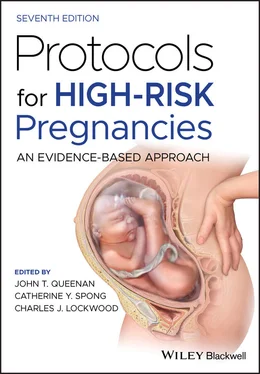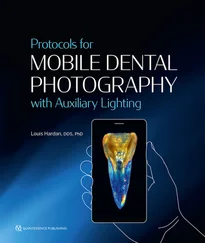Table 11.3 Intravenous preparations for therapy of iron deficiency anemia
Source: Based on ACOG Practice Bulletin No. 107, 2009.
| Type of intravenous iron |
Commercial names |
Dose |
| Iron dextran LMW |
INFeD, Cosmofer |
1000 mg/60 min (diluted in 250–1000 mL of normal saline) |
| Ferric gluconate |
Ferlecit |
125 mg/30 min (diluted in 100 mL of normal saline) |
| Iron sucrose |
Venofer |
200 mg/60 min |
| Ferric carboxymaltose |
Ferinject |
100 mg/15 min |
Erythropoietin is not indicated in the treatment of iron deficiency anemia unless the anemia is caused by chronic renal failure or other serious chronic medical conditions and is expensive with many associated side effects – its use should be reserved for treatment by a hematologist.
Blood transfusion is indicated only for anemia associated with hypovolemia from blood loss or in preparation for a cesarean delivery in the presence of severe anemia.
1 Al R, Unlubilgin E, Kandemir O, et al. Intravenous versus oral iron for treatment of anemia in pregnancy: a randomized trial. Obstet Gynecol 2005; 106:1335–40.
2 American College of Obstetricians and Gynecologists. Neural tube defects. ACOG Practice Bulletin No. 44. Obstet Gynecol 2003; 102:203–13.
3 American College of Obstetricians and Gynecologists. Anemia in Pregnancy. ACOG Practice Bulletin No. 95. Obstet Gynecol 2008; 112:201–7.
4 Breymann C, Milman N, Mezzacasa A, et al. Ferric carboxymaltose vs. oral iron in the treatment of pregnant women with iron deficiency anemia: an international, open‐label, randomized controlled trial (FER‐ASAP). J Perinat Med 2017; 45:443–53.
5 Centers for Disease Control and Prevention. Recommendations to prevent and control iron deficiency in the United States. MMWR 1998; 47:1–29.
6 Kadyrov M, Kosanke G, Kingdom J, et al. Increased fetoplacental angiogenesis during first trimester in anaemic women. Lancet 1998; 352:1747.
7 Klebanoff MA, Shiono PH, Selby JV, et al. Anemia and spontaneous preterm birth. Am J Obstet Gynecol 1991; 164:59.
8 Lieberman E, Ryan KJ, Monson RR, et al. Risk factors accounting for racial differences in the rate of premature birth. N Engl J Med 1987; 317:743.
9 Nguyen V, Wuebbolt D, Thomas H, et al. Iron deficiency anemia in pregnancy and treatment options: a patient‐preference study. Obstet Gynecol 2017; 129:122S.
10 Peña‐Rosas JP, Viteri FE. Effects of routine oral iron supplementation with or without folic acid for women during pregnancy. Cochrane Pregnancy and Childbirth Group. Cochrane Database Syst Rev 2009;( 3).
11 Reveiz L, Gyte GML, Cuervo LG. Treatments for iron‐deficiency anaemia in pregnancy. Cochrane Pregnancy and Childbirth Group. Cochrane Database Syst Rev 2011;( 10):CD003094.
12 Scanlon KS, Yip R, Schieve LA, et al. High and low hemoglobin levels during pregnancy: differential risk for preterm birth and small for gestational age. Obstet Gynecol 2000; 96:741.
13 Scholz R, Young D, Scavone B, et al. Anemia in pregnancy and risk of blood transfusion. Obstet Gynecol 2018; 131:33S.
14 Scott DE, Pritchard JA. Iron deficiency in healthy young college women. JAMA 1967; 199:147.
15 Smith C, Teng F, Branch E, et al. Maternal and perinatal morbidity and mortality associated with anemia in pregnancy. Obstet Gynecol 2019; 134:1234–44.
16 Sutherland S, O’Sullivan D, Mullins J. An association between anemia and postpartum depression. Obstet Gynecol 2018; 131:39S.
PROTOCOL 12 Hemoglobinopathies in Pregnancy
Bradley Sipe and Judette Louis
Department of Obstetrics and Gynecology, Morsani College of Medicine, University of South Florida, Tampa, FL, USA
Hemoglobinopathies are a group of disorders, including sickle cell disease and thalassemias, which affect the structure of hemoglobin. Annually, 300 000 people are born clinically affected by this group of diseases. There are over 270 million heterozygous carriers worldwide.
Sickle cell disease (SCD) is a hemoglobinopathy caused by a single nucleotide substitution leading to abnormal hemoglobin structure. The abnormal shaped, “sickled,” red blood cells then create occlusion of the microvasculature, leading to painful crisis. These crises lead to hospitalizations, decreased quality of life, organ damage, and overall morbidity/mortality. The most significant form of the disease is HgbS‐S (sickle cell anemia). Other compound heterozygous conditions including HgbS‐C and HgbS‐beta‐thalassemia can produce similar, though often less severe clinical disease. Complications of SCD include infection, anemia, and infarction/vasoocclusion which can affect numerous organ systems including renal, cardiopulmonary, and vascular. Major complications associated with SCD include acute chest syndrome, pulmonary hypertension, stroke, renal disease, venous thrombotic events, and osteonecrosis. Patients with SCD are functionally asplenic and therefore are at risk of infections from Streptococcus pneumoniae and Haemophilus influenzae .
In pregnancy, SCD has been associated with adverse outcomes including small for gestational age neonates, pregnancy loss, preeclampsia, and maternal mortality. In the US, 1 in 12 African Americans has sickle cell trait (Hgb A‐S). Among African American newborns, 1 in 300 will have some form of SCD while 1 in 600 will have sickle cell anemia (Hgb S‐S). SCD is inherited in an autosomal recessive manner.
Thalassemias are a group of disorders affecting the production of the interlocking polypeptides of hemoglobin which can lead to microcytic anemia. The two most common types are alpha‐thalassemia and beta‐thalassemia. Depending on the severity of disease, thalassemias may present a mild anemia or a severe anemia requiring regular transfusions and shortened life spans.
Normal hemoglobin structure consists of four subunits, each containing an interlocking polypeptide chain and heme molecule. Normal adult hemoglobin consists of two alpha chains and two beta chains (HbA) or two alpha chains and two delta chains (HbA2). Fetal hemoglobin (HbF) consists of two alpha chains and two gamma chains. Oxygen binds reversibly to the ferrous iron atom in each heme group, facilitating its delivery to tissues throughout the body.
Sickle cell disease is a group of autosomal recessive disorders that result from a single nucleotide substitution of thymine for adenine converting a glutamic acid codon for a valine codon in the beta‐globin polypeptide encoded by the HBB gene on chromosome 11. Carriers of the disease (HbA‐S) have sickle cell trait and are generally unaffected by the disease. Those homozygous for hemoglobin S (HbS‐S) typically have the most severe form of the disease. Compound heterozygotes include those individuals with one copy of the sickle cell gene paired with another abnormality in beta globin production including HbS‐C and HbS‐beta‐thalassemia. Hemoglobin C (HbC) is due to a single nucleotide substitution involving the same nucleotide as HbS but instead of thymine, it is a guanine substitution at the adenine site. Compound heterozygotes experience similar vasoocclusive crisis and anemia as those with HbS‐S; however, it is often less severe.
Alpha‐thalassemia results from a gene deletion involving the HBA1 and HBA2 genes which encode for the alpha globin protein located on the 16th chromosome. Normal individuals will have four copies of the alpha globin gene, two on each of the 16th chromosomes (αα/αα). Individuals who have one missing gene (αα/α‐) are said to be silent carriers without evidence of disease (Hb and MCV tend to be lower levels of normal). Individuals missing two of the four genes have alpha‐thalassemia trait. These genetic disorders can be inherited in either a cis or trans form, which is important for potential effects on the offspring of affected individuals. Trans‐thalassemia trait will have one missing gene on each chromosome (α‐/α‐) and is commonly seen among those of African descent. Cis‐thalassemia trait will have both missing genes on the same chromosome (‐‐/αα) and is most commonly seen among those of Asian descent. The most severe form of alpha‐thalassemia results from abnormalities in all four alpha globin genes resulting in no alpha globin formation (‐‐/‐‐). This leads to hemoglobin Barts which results in high‐output cardiac failure in utero, fetal hydrops, and fetal demise. HbH is the inheritance of one normal copy the gene (α‐/‐‐) and is the most severe form of the disease compatible with life. Clinically, it manifests as moderate microcytic anemia which does not typically require transfusion, although affected individuals may develop a severe anemia requiring transfusion during acute illnesses/infections and during pregnancy.
Читать дальше












